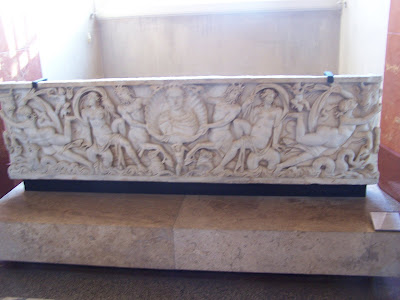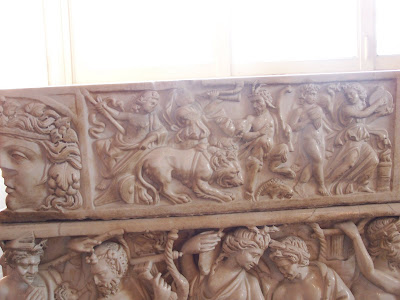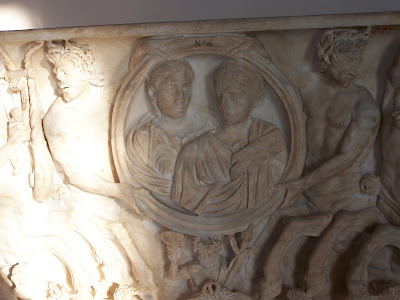Sarcophagus #1-Paris
Sarcophagus of the Muses.
2nd century AD
The main frieze of this sarcophagus depicts the 9 muses each with an iconographic instrument that indicates their specialty. The muse of theatre is holding a theatrical mask, similar to the masks on the corners of the sarcophagus. She is pointing the mask towards Dionysus who is sitting at the far right of the frieze.
The top frieze shows male and female figures reclining with wine, they could be gods. On the sides are theatrical masks, as indicated before.
On the right side of the sarcophagus a woman is sitting with a man holding a book, grape vines are over his head, an indication that this figure could be, or allude to Bacchus. He is making a gesture with his hand, pointing two fingers at her.
On the left side a man is sitting with another woman in front of him. There is a griffin on the top frieze.
This Sarcophagus is filled with bacchic sumbolism, mostly through the depictions of wine and theatre, although there are 9 muses present the on that stands out is the muse of theatre, and the continuation of this theme through the theatre masks above show that theatre was the strongest talent the patron wanted to convey in his sarcophagus. The muses are said to depict the journey to death, and interesting thought seeing as how they are all turned toward Dionysus, except for the one in the middle.







Sarcophagus #2-Paris
220-230 AD
Dionysus is not present in the sarcophagus but many things associated with him are. There is a strong presence of centaurs, wild animals(bulls and goats), and women. The centaurs are holding a portrait in the middle of the sarcophagus, most likely this is the patron. The bacchic iconography is more important than the story.

Sarcophagus #3-Paris
Sarcophagus with the myth of Dionysus and Ariadne.
3rd Centurty AD
Front frieze: Ariadne is shown abandoned in Naxos waiting for Dionysus. The figures of Dionysus and Ariadne first seem hard to depict, there are two women reclining, one on the left of the sarcophagus and one of the right, in each a man is approaching her. However, the woman on the right seems more distressed and the man approaching her has grape vines in her hair, thus concluding they are probably Bacchus and Ariadne. Perhaps the figures on the left are the patrons, trying to relate themselves to the myth. Centaurs with there babies are shown in the center, this is the first sarcophagus I have seen with a family of centaurs. The creatures usually seem to have wild connotations associated with their reputations but here they are depicted as fertile creatures. Figures are surrounding each couple, women and centaurs are towards the couple on the left, while women and godlike figures are towards the couple on the right.
Once again there are theatrical masks of Bacchus on the top sides of the sarcophagus.
On the left side of the sarcophagus a centaur is playing a flute while on the right side a man is with a child and a goat under a tree.
The top frieze is of the Dionysian triumph, perhaps Hercules is there because there is a lion in the triumph, but this could just be a wild animal present in the cult.








Sarcophagus #4-Paris
Selene and Endymion
3rd century AD
I chose this sarcophagus because it is the same subject as the one in Campo Santo, Pisa. Stylistically it is very similar to the Sarcophagus with the myth of Dionysus and Ariadne. There are many figures who fill up a complicated looking frieze, although it is the story of Selene and Endymion, not of Dionysus and Ariadne. That does not mean that there is not Baccic iconography. There are once again theatre masks on the sides of the sarcophagus, and wild animals, such as horses,and goats surround the two figures, just as the Sarcophagus with Bacchus and Ariadne did. So do half naked figures, and small winged children, like man Dionysian sarcophagi, there is a main subject, surrounded by many bizarre figures who represent fertility.





Sarcophagus #5-Paris
Dionysus and Ariadne drug by the Centaurs
230 AD
This sarcophagus depicts a procession with Ariadne, Dionysus, and a center couple. Ariadne is being drug on a cart by the centaurs on the right of the main freize, while Dionysus is being drug by centaurs on the left of the frieze. This could be a demonstration of the Indian triumph. In the center of the sarcophagus there is a couple, a woman with a younger looking man, possible her child, being held by centaurs as well. This theme was common in the sarcophagi at Campo Santo, Pisa, which dated back to around this time period as well. By doing this the patrons are associating themselves with Dionysus and Ariadne,, it is a funeral procession above all else. There are babies and young children present, perhaps this is a tribute to the young boy in the center, if he died early. Once again, this marble sarcophagus is filled with figures surrounding three different scenes.




l






 Sarcophagus #2-Paris
220-230 AD
Dionysus is not present in the sarcophagus but many things associated with him are. There is a strong presence of centaurs, wild animals(bulls and goats), and women. The centaurs are holding a portrait in the middle of the sarcophagus, most likely this is the patron. The bacchic iconography is more important than the story.
Sarcophagus #2-Paris
220-230 AD
Dionysus is not present in the sarcophagus but many things associated with him are. There is a strong presence of centaurs, wild animals(bulls and goats), and women. The centaurs are holding a portrait in the middle of the sarcophagus, most likely this is the patron. The bacchic iconography is more important than the story.
 Sarcophagus #3-Paris
Sarcophagus with the myth of Dionysus and Ariadne.
3rd Centurty AD
Front frieze: Ariadne is shown abandoned in Naxos waiting for Dionysus. The figures of Dionysus and Ariadne first seem hard to depict, there are two women reclining, one on the left of the sarcophagus and one of the right, in each a man is approaching her. However, the woman on the right seems more distressed and the man approaching her has grape vines in her hair, thus concluding they are probably Bacchus and Ariadne. Perhaps the figures on the left are the patrons, trying to relate themselves to the myth. Centaurs with there babies are shown in the center, this is the first sarcophagus I have seen with a family of centaurs. The creatures usually seem to have wild connotations associated with their reputations but here they are depicted as fertile creatures. Figures are surrounding each couple, women and centaurs are towards the couple on the left, while women and godlike figures are towards the couple on the right.
Once again there are theatrical masks of Bacchus on the top sides of the sarcophagus.
On the left side of the sarcophagus a centaur is playing a flute while on the right side a man is with a child and a goat under a tree.
The top frieze is of the Dionysian triumph, perhaps Hercules is there because there is a lion in the triumph, but this could just be a wild animal present in the cult.
Sarcophagus #3-Paris
Sarcophagus with the myth of Dionysus and Ariadne.
3rd Centurty AD
Front frieze: Ariadne is shown abandoned in Naxos waiting for Dionysus. The figures of Dionysus and Ariadne first seem hard to depict, there are two women reclining, one on the left of the sarcophagus and one of the right, in each a man is approaching her. However, the woman on the right seems more distressed and the man approaching her has grape vines in her hair, thus concluding they are probably Bacchus and Ariadne. Perhaps the figures on the left are the patrons, trying to relate themselves to the myth. Centaurs with there babies are shown in the center, this is the first sarcophagus I have seen with a family of centaurs. The creatures usually seem to have wild connotations associated with their reputations but here they are depicted as fertile creatures. Figures are surrounding each couple, women and centaurs are towards the couple on the left, while women and godlike figures are towards the couple on the right.
Once again there are theatrical masks of Bacchus on the top sides of the sarcophagus.
On the left side of the sarcophagus a centaur is playing a flute while on the right side a man is with a child and a goat under a tree.
The top frieze is of the Dionysian triumph, perhaps Hercules is there because there is a lion in the triumph, but this could just be a wild animal present in the cult.







 Sarcophagus #4-Paris
Selene and Endymion
3rd century AD
I chose this sarcophagus because it is the same subject as the one in Campo Santo, Pisa. Stylistically it is very similar to the Sarcophagus with the myth of Dionysus and Ariadne. There are many figures who fill up a complicated looking frieze, although it is the story of Selene and Endymion, not of Dionysus and Ariadne. That does not mean that there is not Baccic iconography. There are once again theatre masks on the sides of the sarcophagus, and wild animals, such as horses,and goats surround the two figures, just as the Sarcophagus with Bacchus and Ariadne did. So do half naked figures, and small winged children, like man Dionysian sarcophagi, there is a main subject, surrounded by many bizarre figures who represent fertility.
Sarcophagus #4-Paris
Selene and Endymion
3rd century AD
I chose this sarcophagus because it is the same subject as the one in Campo Santo, Pisa. Stylistically it is very similar to the Sarcophagus with the myth of Dionysus and Ariadne. There are many figures who fill up a complicated looking frieze, although it is the story of Selene and Endymion, not of Dionysus and Ariadne. That does not mean that there is not Baccic iconography. There are once again theatre masks on the sides of the sarcophagus, and wild animals, such as horses,and goats surround the two figures, just as the Sarcophagus with Bacchus and Ariadne did. So do half naked figures, and small winged children, like man Dionysian sarcophagi, there is a main subject, surrounded by many bizarre figures who represent fertility.




 Sarcophagus #5-Paris
Dionysus and Ariadne drug by the Centaurs
230 AD
This sarcophagus depicts a procession with Ariadne, Dionysus, and a center couple. Ariadne is being drug on a cart by the centaurs on the right of the main freize, while Dionysus is being drug by centaurs on the left of the frieze. This could be a demonstration of the Indian triumph. In the center of the sarcophagus there is a couple, a woman with a younger looking man, possible her child, being held by centaurs as well. This theme was common in the sarcophagi at Campo Santo, Pisa, which dated back to around this time period as well. By doing this the patrons are associating themselves with Dionysus and Ariadne,, it is a funeral procession above all else. There are babies and young children present, perhaps this is a tribute to the young boy in the center, if he died early. Once again, this marble sarcophagus is filled with figures surrounding three different scenes.
Sarcophagus #5-Paris
Dionysus and Ariadne drug by the Centaurs
230 AD
This sarcophagus depicts a procession with Ariadne, Dionysus, and a center couple. Ariadne is being drug on a cart by the centaurs on the right of the main freize, while Dionysus is being drug by centaurs on the left of the frieze. This could be a demonstration of the Indian triumph. In the center of the sarcophagus there is a couple, a woman with a younger looking man, possible her child, being held by centaurs as well. This theme was common in the sarcophagi at Campo Santo, Pisa, which dated back to around this time period as well. By doing this the patrons are associating themselves with Dionysus and Ariadne,, it is a funeral procession above all else. There are babies and young children present, perhaps this is a tribute to the young boy in the center, if he died early. Once again, this marble sarcophagus is filled with figures surrounding three different scenes.



 l
l
2 comments:
Re: sarc. #5, could it be the wedding procession of Dion. and Ariadne (instead of the Indian Triumph)? At least, I'd be interested to hear your reasoning for the latter.
There seems to be a strong corrolation in funerary iconography between marriage and death. It's sort of all over the place in the images of the sarc. you've gathered to date.
Selene and Endymion is very imp., too: as you know, Selene, the moon goddess, fell in love with Endymion. Endymion was given by Zeus the gift of eternal sleep as a means of conquering death. But, of course, sleep and death are (figuratively) twin brothers.
AGM
I found it hard to distinguish between the Indian Triumph and the Marriage of Ariadne and Dionysus. It does seem obvious that this is a marriage procession between the two, but in this sarcophagus, and others, I thought that the inclusion of Centaurs and Maenads might also allude to the Indian Triumph, but perhaps I am reading too much into the symbolism.
Post a Comment